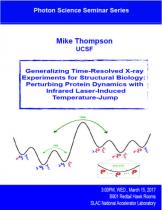Speaker: Michael Thompson, UCSF
Program Description
Structural interconversions drive the biological function of protein molecules, yet the atomic details of these motions remain elusive. Time-resolved X-ray scattering and diffraction are among the most information-rich experimental techniques for the study of protein dynamics, because they provide simultaneous structural and kinetic information at high resolution. Although they have the potential to provide a wealth of information, these experiments have not been broadly applied by structural biologists. To date, systems that have been rigorously studied are those in which a protein conformational change is coupled to excitation of a photoactive ligand molecule, because the conformational change can be initiated with an ultrafast laser pulse. Unfortunately, the number of proteins that undergo photochemistry as part of their functional cycle is small, and there is a fundamental need to develop methods that can be used to synchronously excite conformational transitions in any protein molecule, even in the absence of specific photochemistry. While protein photoactivity is rare, our experience over multiple systems has demonstrated that temperature perturbation is an effective and generalizable way to experimentally manipulate the conformational landscape of a protein for crystallographic studies. Building on these results, our current goal is to develop time-resolved X-ray experiments that utilize infrared laser-induced temperature-jump (T-jump) methods to synchronize conformational dynamics. Results of time-resolved T-jump SAXS/WAXS experiments, performed on a model enzyme (human cyclophilin A), will be presented. These measurements demonstrate that even modest T-jumps produce a measurable change in X-ray scattering by the protein, and yield structural and kinetic insight into the coupling between protein dynamics and solvent reorganization. Crystallographic T-jump experiments, underway at LCLS will also be discussed. These experiments will reveal the atomic motions that underlie conformational transitions with unprecedented detail. Because laser T-jump methods exploit photochemistry of the solvent, and not the protein molecules, we hope they will be universally applicable as a tool for studying protein dynamics at both synchrotron and XFEL light sources.
Bio
Michael Thompson is a postdoctoral fellow in James Fraser’s group in the Department of Bioengineering and Therapeutic Sciences at the University of California, San Francisco (UCSF). His research is directed toward understanding how enzymes navigate complex energetic landscapes in order to achieve their functions as nature’s chemical catalysts. This work combines high-resolution X-ray crystallography with other biochemical and biophysical tools, in order to characterize structural states that define catalytic activity and reveal the dynamics of their interconversion. He also has an active interest in developing X-ray techniques for studying protein structure and dynamics. Michael received his Ph.D. in Biochemistry and Molecular Biology from the University of California, Los Angeles (UCLA) in 2014, where he studied structure-function relationships in a key family of proteins that define a widespread class of prokaryotic organelles collectively known as “bacterial microcompartments.”





